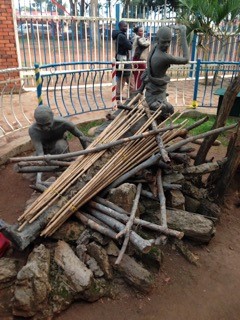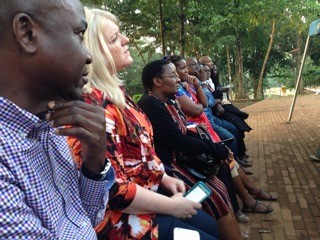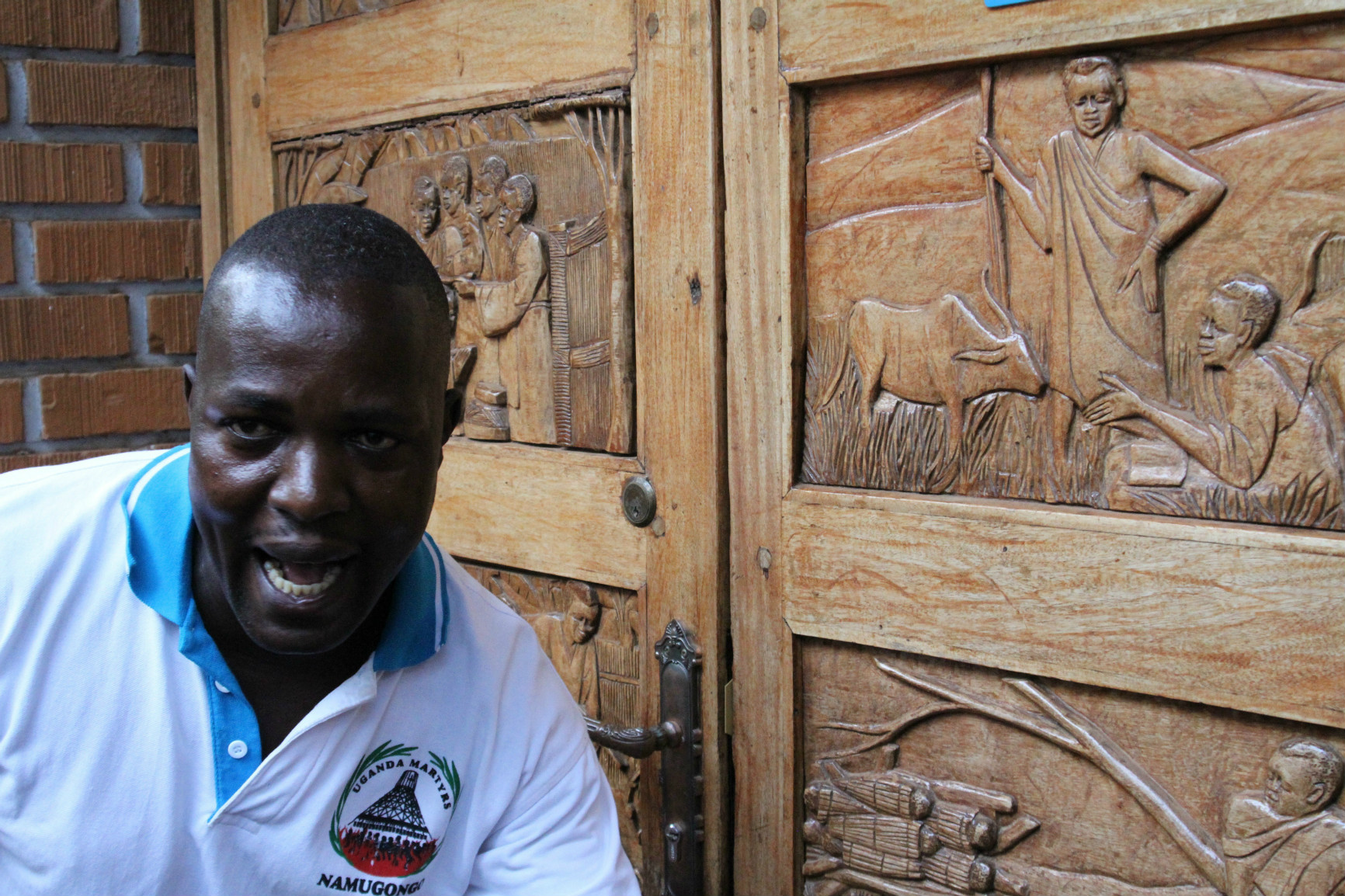[First posted on Wednesday, November 25, at 12:23 p.m.]
Pilgrims walk hundreds of miles to swat at mosquitoes and dip their jugs, body parts, and even their babies into the murky water of a rectangular lake here on the northeast outskirts of Uganda’s capital city.
Millions of faithful Catholics show up in Kampala on “Martyrs Day” every June 3 from all over East Africa. They commemorate 45 young men—23 Catholics and 22 Anglicans—who died for their faith in the late 1800s as Ugandan political winds shifted. For this year’s observance, 500 pilgrims from Kenya spent more than a month walking 300 miles on foot to reach the Martyrs’ Shrine in Namugongo, according to the Vatican.
“What did you know at age 15?” said Jane Frances, a nun with the Comboni Missionary Sisters in Uganda, while on a recent flight from Kampala to Ethiopia. “At that young age, they were so brave. They were burned to death.” She attends the remembrance every year if she is not traveling.
 Ramata Sore
Ramata SoreOn his first trip to Africa last week, Pope Francis visited all three of Kampala’s martyrs shrines, dedicated to a group of young men who stood up to an unjust king and, in so doing, shook the conscience of the country toward religious freedom.
First, on Friday (November 27) Francis stopped at the Munyonyo Martyrs’ Shrine that honors the first three young men killed in 1886. Then on Saturday (November 28), he visited two other shrines that honor more victims: the Nakiyanja Protestant Martyrs’ Shrine and the Namugongo Catholic Martyrs’ Shrine, where he celebrated mass and urged Christians to remember the legacy of their spiritual ancestors.
"The Christian community in Uganda grew strong through the witness of the martyrs," said Francis, the third pope to visit Africa. "The message you bring will take root all more firmly in people's hearts if you are not only a teacher but also a witness … of the beauty of prayer, the power of mercy and forgiveness, the joy of sharing in the Eucharist with all our brothers.”
At the site where the martyrs were killed, the pope knelt down and prayed. Later, he encouraged Christians to evangelize and helped plant a unity tree with Catholic and Anglican bishops, reportsThe New York Times.
Catholics have heralded the site and its history much more than Protestants.
 Ramata Sore
Ramata SorePope Paul VI canonized Namugongo’s 23 Catholic martyrs in 1964, and visited the shrine in 1969. Pope John Paul II visited in 1993 and elevated the teepee-like church to a minor basilica—a church given special designation by a pope for its historical, architectural, or artistic worth.
A few days before the news broke of the pope’s planned visit, journalists from across Africa toured the site in Namugongo with visiting Americans. A Ugandan church choir practiced in the shade as groups of uniformed school children set up chairs for an upcoming service. The tour guide, Ben Tenywa, explained the surreal political and religious context before breaking into graphic detail about the martyrs.
Persecution in Uganda started in 1857 when a Muslim king decided he didn’t want to follow some teachings of Islam, and felt judged by those who did. King Muteesa I initially adhered to Islam, but didn’t want to give up pork or be circumcised as prescribed by the religion. So when his Muslim subjects refused to eat the pork he provided them, he had dozens of them killed.
Later, Muteesa invited missionaries to bring Christianity to his people with a letter to Queen Victoria in 1875, which prompted Anglicans and Catholics to spread their teachings in the region. But when Muteesa I died in 1884, his son Mwanga II became king at a young age.
“They died singing hymns,” said Jenny Taylor, director of Lapido Media, a center for religious literacy based in London.Witch doctors convinced Mwanga that Christians and Muslims were causing trouble in the country by encouraging people to abandon traditional gods. They suggested the converts might challenge the king’s authority. He was also angry that Christians rebuffed his sexual advances toward some of them. For these slights, he gave a green light to kill those who acknowledged a higher authority.
 Paul Glader
Paul GladerSo young men were put in chains. When they refused to renounce their faith, Mwanga’s loyalists cut off their hands and legs and put the limbs on display at the local trading market to discourage other Christians from belief. Other men were burned alive, fed to dogs, beheaded, castrated, or speared to death.
“The martyr bears witness with extraordinary fortitude to the belief that Christ suffered, died, and rose from the dead for our salvation and to the truth of our faith (the word martyr itself means ‘witness’),” writes Tenywa in a booklet for sale at the Namugongo site. “Sacred scripture attests to the courage of men and women who were willing to die as martyrs rather than renounce their faith or be unfaithful to God’s law.”The bravery of the young men—and their reported humility and resolute faith in the face of such torture and death—is what makes them so inspirational to millions of Africans.
In addition to the Catholics murdered at Namugongo, 22 Anglicans refused to renounce their faith and were also brutally murdered by Mwanga’s men.
“The Catholics remember this,” said Barbara Kaija, editor-in-chief of Uganda’s largest newspaper, TheNew Vision, while walking on the tour. “The Protestants don’t make as big a deal out of it.”
 Paul Glader
Paul GladerNearly 90 percent of Uganda’s population of 33 million identifies as Christians. They are split nearly 50/50 between Protestants and Catholics, according to the Pew Research Center.
In the 1970s, Ugandan president Idi Amin Dada sought the favor of Anglican archbishop Janani Luwum, even as Amin had up to 500,000 people murdered during his despotic reign. But Luwum joined with Catholics and Muslims to oppose Amin’s brutality. Just five days after objecting to Amin’s violence, Luwum was killed on February 17, 1977—a day the Anglican church now remembers each year. Luwum’s statue stands above the main door of Westminster Abbey, showing the impact of modern martyrs in Uganda.
And a New Vision piece last month headlined “Nakiyanja-Namugongo wakes up” suggests Uganda's Protestants are starting to improve their own martyrs’ shrine, which is in the exact location of where most of the young men—Catholics and Anglicans—were murdered. The October 24 story said Uganda’s Anglican church is spending $10.7 million on renovations to the site.
For many years, “the Anglican shrine has been overshadowed by the Catholic shrine,” New Vision reported. “During the last Martyrs Day, on June 3, President Yoweri Museveni criticized the Anglican clergy over failure to popularize the Protestant martyrs. … He asked the Church of Uganda to emulate their Catholic counterparts.”
 Paul Glader
Paul GladerMore recently, Museveni told Anglican leaders he was proud their Nakiyanja shrine had been improved from a local site to a national site, but hoped it could become more internationally recognized, similar to the Catholic Namugongo shrine that offers materials in three languages and has become a key tourist attraction in Uganda alongside safaris.
At the Catholic shrine, an oddly rectangular lake played host to thousands, including priests and political leaders. A gazebo in the middle of the water is where the pope stood. The crowds surrounded the lake on wooden grandstands on all sides.
During the recent tour for journalists, Alexis Kubana said his friend had a baby who had a skin rash on her arm. “My friend put the baby in the lake. She became better after a few days.” Whether a miracle occurred or not, the 26-year-old and others believe that visiting the shrine once a year results in blessing. Kubana came to Kampala as a toddler, escaping the genocide in Rwanda with his mother and brother (his mother died two months after they arrived). He now works for NGOs that train refugees in basic computer skills.
The tour guide, Tenywa, said people believe the water is holy because the executioners bathed in the lake, washing off the blood of the men they killed. “The blood of the martyrs sanctified the pond,” he said.
One newspaper editor from Tanzania named Simon Mkina brought some plastic jugs to the site, dipped them into the lake to fill them up, and joked that he was going to drink the water later.
 Ramata Sore
Ramata Sore“You have to boil it first,” said another editor from Ethiopia named Benutu.
“No, you don’t,” Mkina said. “Some people boil it. Some people don’t.”
“You can’t argue with someone who says they received a miracle here,” Benutu said.
Sub-Saharan Africa had roughly 516 million people who identified as Christian in 2010, making up 62.7 percent of the total population, according to Pew.
Frances said she realizes that some people in Western societies believe that many Africans go to church because they are poor. “They think that when we become rich, we will forget to pray,” she said. “I don’t think so.” On the short flight, she read her Bible and prayed at both takeoff and landing.
Other critics suggest that Christianity is a recent arrival to Africa and that the missionaries who brought it have done more harm than good to the tribes and people on the continent. Meanwhile, some theologians and historians say such a view is shallow and shortsighted.
Desta Heliso, director of the Ethiopian Graduate School of Theology in Addis Ababa, cites theologian Thomas C. Oden’s explanation that Christianity in Africa is not a modern phenomenon that replaced traditional practices. Rather, Oden points out that Africa shaped the Christian mind from ancient times with scholars such as Augustine, Plotinus, Tertullian, and Clement of Alexandria. He also emphasizes that African Christians played a role in developing the modern university, refining rhetorical skills, and establishing early monasticism and other practices of the early church.
 Paul Glader
Paul Glader“Thought and movement in early Christianity were even more inland in Namibia and other places,” Heliso said. “Early cultures were interacting” from the northern rim of Africa that intersected with Europe, as well as interior regions of Africa, he said.
Church historians in Uganda say the young Catholic and Anglican men walked to their deaths singing hymns and praying for their enemies. Their example inspired bystanders and caused Christianity to continue to spread among Ugandans, causing more Africans to share their faith with one another. In doing so, they also proved their faith wasn’t just that of white people visiting from Europe. Uganda now has one of the highest percentages of professing Christians among all African nations.
“The Catholic church in Uganda is doing pretty well,” Frances said. In May, the Ugandan press reported than the Catholic Church will spend $1.6 million restoring another site where three of the martyrs were buried. “The most important thing for us is there are no restrictions on worship. We worship and we are free.” She worries about the lack of religious freedom in places such as Somalia, Chad, and Egypt.
Why did the murders and persecution of Christians stop in 1887?
“The king was told by his mother to stop killing the good people,” Tanywa said. “The only people who can address the king like that is his mother.”
He said Mwanga stopped punishing people for silly offenses and started forgiving offenses against the regime that were based in religious conviction. In exile, the king became a Christian and was baptized.
“A country with this kind of history simply values religious freedom,” said Emeke Izeze, managing director of The Guardian in Nigeria, walking the grounds of the Namugongo shrine. “The real question is whether the religious freedom translates to political freedom. Democracy still has yet to take root.”
Some countries in Africa, such as Ethiopia, allow for religious freedom but not for press freedom. Some countries, such as Nigeria, are having difficulty controlling religious violence from terrorist organizations such as Boko Haram. Somalia has failed to curb Islamist terrorist groups such as al-Shabab within its borders. Other countries are struggling to curb government corruption, to allow for free elections, and to ensure foreign aid reaches the most needy citizens and infrastructure gaps.
Uganda has received criticism from Western media and governments because some of its politicians and religious leaders have called for prosecuting gays and lesbians. Local journalists in Uganda said religion has helped Ugandans understand that traditional practices such as polygamy, adultery, and coercive homosexual behavior are not acceptable norms. They believe this has helped improve public health and curb the spread of HIV/AIDs and other diseases. Meanwhile, many religious Ugandans are still sorting out a balance between personal morality and how society should accommodate basic human rights as well as religious freedom.
 Ramata Sore
Ramata SorePope Francis previously said that during his visit to Uganda, he planned to focus on religious discussions rather than political discussions. Religious leaders in the country aimed to raise $14 million to support his visit, according to local news sources.
Earlier this year, the Anglican church of Uganda asked the country to declare Feb. 16 a holiday to commemorate Luwum. In addition to setting aside the holiday, President Museveni pledged to erect a statue of the archbishop in Kampala, to build schools in his honor, and to establish a museum to honor Luwum’s contributions to God and country, according to the Anglican Communion News Service.
Uganda also plans to build a museum to remember 30 people killed by the Lord’s Resistance Army, led by Joseph Kony, in 2002. Lapido Media's Taylor says religious literacy helped defuse that war in the early 2000s, bringing Catholics and Protestants together to oppose Kony and the LRA and to form the Acholi Religious Leaders’ Peace Initiative.
Taylor says Uganda’s spiritual heritage is particularly rich, serving as a legacy to the rest of Africa and global Christendom. She points out that the first black bishop and archbishop in the Church of England, John Sentamu, is Ugandan. She notes the first black Director for Africa for the Church Mission Society, Zac Niringiye, was also Ugandan.
According to Taylor, Uganda can remind Christians worldwide of the importance of recording the history of martyrs and marking the geographic spots for future visitors.
 Paul Glader
Paul GladerRanked No. 14 on a recent African prosperity report, Uganda is placing many of its economic bets on tourism. According to the World Travel and Tourism Council, tourism employs roughly 264,000 people in Uganda and accounts for as much as 7.2 percent of the nation’s GDP.
But while the country boasts mountains, lakes, savannahs, and more than half of the world’s gorillas, the greater diversity of wildlife in neighboring countries has left Ugandan leaders concluding that the country can’t compete.
Religion provides Uganda a competitive advantage to attract tourists. In addition to its martyrs sites, it is also home to Africa’s second-largest mosque and a 15,000-seat megachurch, the biggest in East Africa.
At the forefront of growing the tourism industry is Museveni, who previously criticized the Church of Uganda for its lack of enthusiasm at finding ways to generate revenue. The Anglican martyrs site may fulfill that purpose, a Ugandan Anglican bishop opined earlier this year.
“In addition to martyrs being witnesses of Christ and inspiring faith of believers in the Anglican [church], they can be a source of income to the church in this era of faith tourism,” wrote Fred Mwesigwa for The Monitor. “And after all, as one Nigerian Protestant accountant put it, ‘Money pushes the gospel.’”


















